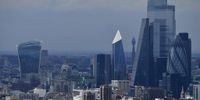Britain’s economy, long the subject of anxious speculation among investors and policymakers alike, delivered a modest surprise in August 2025: a 0.1% uptick in growth, according to official data released Thursday by the Office for National Statistics (ONS). While hardly a blockbuster, this slight expansion—coming on the heels of a downwardly revised 0.1% contraction in July—offered a glimmer of hope for Finance Minister Rachel Reeves as she looks ahead to her highly anticipated November budget.
The latest figures, as reported by Reuters and The Wall Street Journal, confirm that the UK’s economic recovery remains fragile and uneven. August’s 0.1% growth, though in line with economists’ expectations, marks just the second month of expansion since April, underscoring the persistence of slow growth that has characterized much of 2025. In the three months leading up to August, GDP picked up slightly to 0.3%, a marginal improvement from the 0.2% growth seen in the previous three-month period, according to the ONS.
But beneath these surface numbers lies a more complicated story. The services and construction sectors, typically engines of job creation and investment, have been described as being in a “pre-budget funk” by Sanjay Raja, chief UK economist at Deutsche Bank. Raja told Reuters that he expects third-quarter growth to be about half the Bank of England’s estimate of 0.4%, citing the lingering effects of global trade tensions and domestic policy uncertainty. “The UK economy has yet to see the full ramifications of the U.S. trade war,” Raja said. “Budget uncertainty is hitting its peak too – likely dampening discretionary household and business spending.”
Indeed, the specter of the upcoming November 26 budget looms large. Finance Minister Rachel Reeves is widely expected to introduce tax increases in an effort to shore up public finances, a move that has already cast a shadow over consumer and business sentiment. According to the ONS, consumer-facing services actually shrank in August, even as public health service work provided a modest boost to overall growth. Retail sales, a closely watched indicator of economic health, have also shown signs of weakness in recent weeks—reflecting, at least in part, widespread concerns about possible tax hikes.
Adding to the sense of unease, the labor market is showing signs of strain. Bank of England Governor Andrew Bailey, speaking earlier this week, noted that the jobs market is “softening,” with unemployment rising to its highest level since 2021 and private sector wage growth slowing. These trends, highlighted by both Reuters and The Wall Street Journal, suggest that the UK’s post-pandemic recovery is running into headwinds just as policymakers are being asked to make tough fiscal choices.
Monetary policy, too, is at a crossroads. The Bank of England opted to hold interest rates steady at 4% in September, as it tries to strike a delicate balance between combating stubbornly high inflation and supporting weak growth. This cautious approach reflects mounting concerns that aggressive tightening could tip the economy into recession, even as inflation remains above the central bank’s 2% target. Monetary Policy Committee member Alan Taylor warned that the British economy risks a “bumpy landing,” pointing in part to the impact of U.S. President Donald Trump’s trade tariffs—a reminder that Britain’s economic fortunes are increasingly tied to global developments.
Internationally, there is at least one silver lining. The International Monetary Fund (IMF) recently forecast that the UK will post the second-fastest growth among the Group of Seven (G7) nations in 2025, trailing only the United States. The IMF projects 1.3% growth for the UK this year—a respectable showing in a world of sluggish expansion, but not enough to spare British households and businesses from the prospect of higher taxes. As Reuters put it, “at 1.3% its annual pace of expansion is not enough to avoid the need for tax increases in Reeves’ budget.”
For policymakers, the challenge is clear: how to restore confidence and momentum in an economy buffeted by both domestic and international shocks. Fergus Jimenez-England, an associate economist with the National Institute of Economic and Social Research, told Reuters that early indicators for September point to only limited growth in the third quarter. “Regaining momentum hinges on restoring business confidence and reducing uncertainty, which the government can support by setting aside a larger fiscal buffer in the upcoming budget,” Jimenez-England said.
Yet, as the November budget approaches, the path forward remains fraught with uncertainty. Data published earlier this week showed weak growth in retail sales, partly reflecting worries about possible tax increases. Households and businesses are holding back on discretionary spending, waiting to see how Reeves will balance the books. The government faces a tricky balancing act: raise taxes too steeply, and risk choking off an already tepid recovery; go too easy, and risk undermining investor confidence in Britain’s fiscal discipline.
Meanwhile, the broader political context cannot be ignored. With the UK economy expected to grow more quickly than most of its G7 peers, there is pressure on the government to capitalize on this relative strength. Yet, the persistent drag from global trade tensions—especially those stemming from the ongoing U.S. trade war—remains a significant obstacle. As Alan Taylor and others have warned, the full effects of these tariffs may not have been felt yet, suggesting that further challenges could be on the horizon.
For ordinary Britons, the stakes are high. Rising unemployment and slowing wage growth threaten to erode living standards, even as inflation eats into household budgets. The prospect of higher taxes, coupled with weak growth and global uncertainty, has left many feeling anxious about the future. As one might expect, the mood among business leaders and consumers is cautious, if not outright pessimistic.
Still, there are reasons for cautious optimism. The UK’s ability to eke out even modest growth in the face of formidable headwinds speaks to the underlying resilience of the economy. Policymakers, for their part, are keenly aware of the risks and appear committed to navigating a path that supports both growth and fiscal responsibility. As the November budget draws nearer, all eyes will be on Rachel Reeves and her team to see whether they can strike the right balance and set the stage for a more robust recovery in 2026 and beyond.
With so much riding on the decisions to be made in the coming weeks, the story of Britain’s economic recovery is far from over. For now, the country finds itself in a holding pattern—waiting, watching, and hoping that the next chapter will bring more than just incremental gains.




